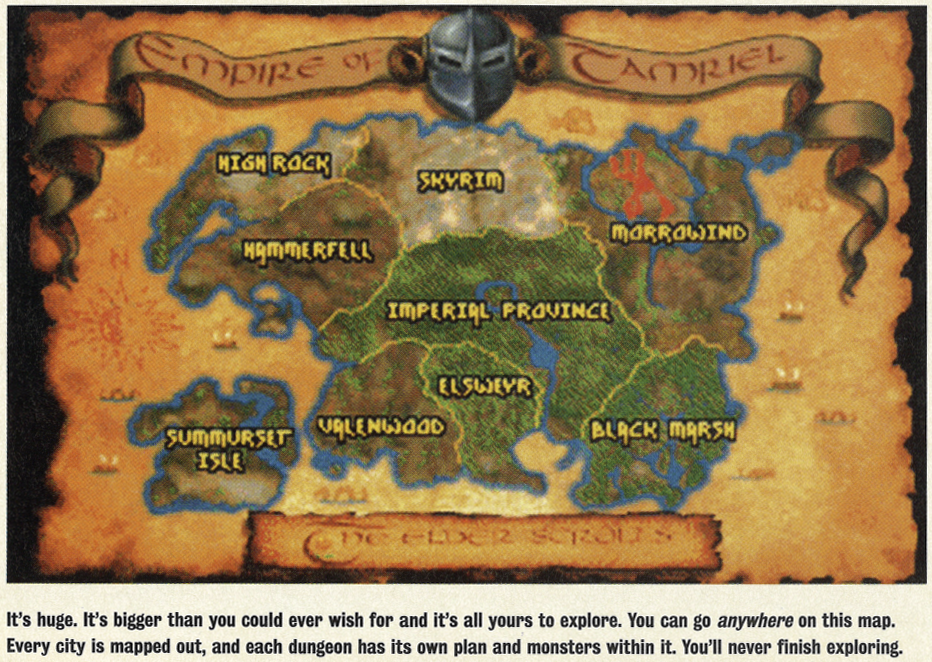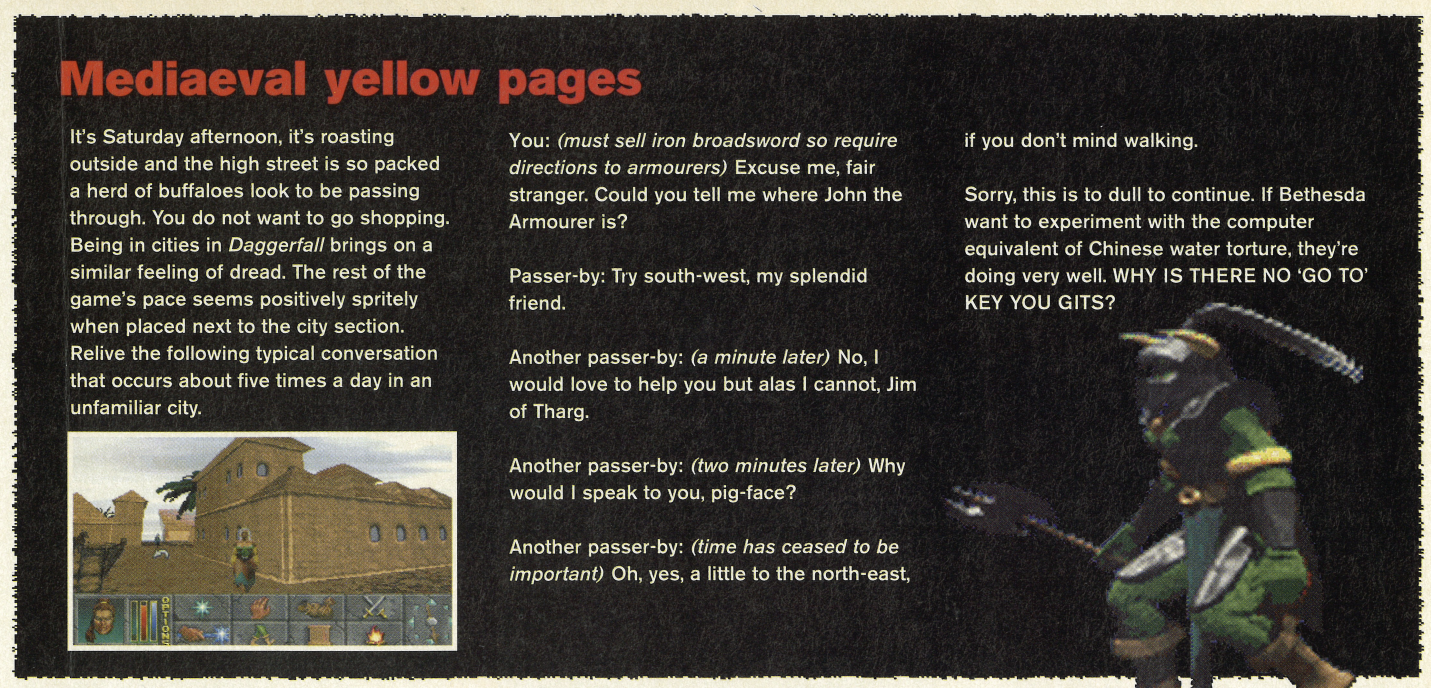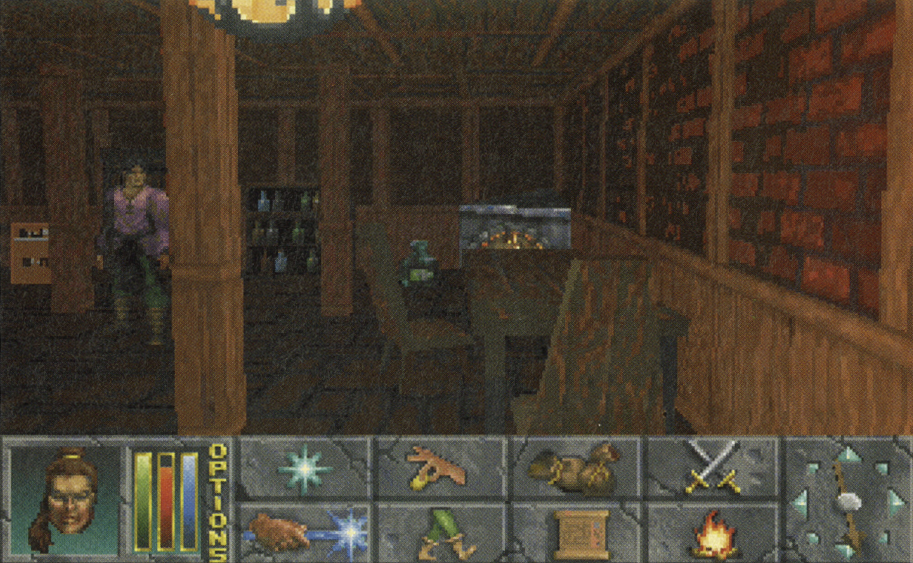The Elder Scrolls II: Daggerfall review
To celebrate the 30th anniversary of The Elder Scrolls, we're publishing our original reviews of each main game in the series from our archives. This review first ran in PC Gamer UK issue 35, back in September 1996.
As with Arena, the sheer size and freedom offered from the series becomes its key selling point—here James admits to playing the game for more than 70 hours and still not feeling like he'd made a dent. While Daggerfall picks up a couple of extra points over its predecessor, it just misses breaking the 90% barrier—its ageing presentation holding it back. "Quite how they've managed to produce such an ugly grey look with Spectrum fonts is a mystery." If you'd like to experience Daggerfall yourself, we've got a step-by-step guide to playing this slice of Elder Scrolls history on modern PCs.

Developer Bethesda Softworks
Minimum system 486DX2/66, 8Mb RAM
Recommended Pentium 100, SVGA
Sound support All major cards
Release date September 20, 1996
If you had to give a percentage score to your life to date, what would it be? Consider school, the worst ever jobs, parents, friends, sport… all the successes and failures that have been crammed into the past 25 years or so. Now imagine playing Daggerfall, and you'll probably have to use a similar process to arrive at a mark.
I've been playing Daggerfall for about 70 hours now and have got absolutely nowhere. The feeling, as I have to say 'enough is enough', is one of those impossible-to-pinpoint ones of reward and satisfaction with a little frustration added to the emotional broth for good measure. It's the sort that wanders your way after a few days of real-life time that have been challenging and passed enjoyably but, well, have achieved nothing that you'd give yourself a self-congratulatory back-slap for.
So is it any good? Yes. Very. But it's also very, very slow. It's not quite as structure-less as Elite, but almost. At the start of the game you find yourself sitting in a dungeon and, you reason, Priority One must be escape. So, after duly hacking your way around dark corridors and large caverns for a few hours, the exit leaps out from a wall, and you emerge into the shining daylight. You look at your log book, that tome of events, quests and missions that Bethesda have kindly provided, and which will grow to a truly vast size within a couple of days of playing. And then you wonder if you just enjoyed yourself.
The answer would have to be yes. The combat you've just experienced is the same as in the original – to fight you hold the right mouse button down and swish the mouse around to move your weapon. The direction you swish in governs each blow's power and accuracy, and therefore damage. It's a system that works very well and keeps you in the midst of the action at all times. The scenery is varied and large, and the design of all the dungeons actually makes sense. Daggerfgall is packed with monsters, items, interesting room designs, an auto-map and everything you could wish for to make a good Ultima Underworld style adventure.

The 3D Xngine technology is one of the best out there, giving full freedom of movement in a texture mapped world with jumping and crouching and a control method similar to Terminator: Future Shock's. The monsters are still bitmap based, and look a little dated next to Quake's polygons, but as you just want to kill most of them it doesn't really matter. These underground antics (which eventually comprise the majority of the playing time) are complemented by the city sections. Here the game assumes a more sedate pace.
It's impossible not to become side tracked by the vast number of opportunities available
Entering a new city for the first time is a sobering experience. They're big and full of people. You have no idea where to go or what to do. Looking at your log book reveals the barest hint of the quest that presumably runs throughout the game and provides the main challenge. However, it's impossible not to become side tracked by the vast number of opportunities available. Join guilds and become a member of a temple for starters. Receive training and then undertake some simple quests for money, fame or plain experience. As you succeed your reputation grows and precedes you. If your kick is killing civilians (always a bundle of laughs in the original) then an assassin's reputation awaits you. It's also considerably harder to fight off the town guards that come to stop you, and now failure means prison (487 days seems to be the par for a first murder offence).
But, just like those old DOS-based text adventures and 'real' role-playing games, Daggerfall's heart lies with your character advancement. Your character has various physical and mental attributes, and 12 skills which are based on these. As you adventure and use them they improve, and you get better at them. Also, exploring, ransacking and general pillaging turns up new equipment that you can either sell or use. So, you progress along this path and, assuming you don't get killed, control a mega-powerful character. Looking after the character and building it up is what makes the game so enjoyable, and thankfully the save game facility is now almost instant so it makes cautious dungeon exploration an enticingly dangerous prospect.

Where Daggerfall scores so highly is the enormous scope of the world you can explore. The entire continent has again been created in mind numbing detail, with towns, villages, temples, and dungeons being listed all across it. Travelling around it, the people change to reflect the climate, and the whole experience seems even more authentic. Combined with the characters, this is what makes the game. Lords of Midnight 3, Frontier II and Privateer have tried to create a free, yet structured world but none have come close to this.
Where Daggerfall has improved over the first game (which was largely responsible for putting Bethesda's name in gamer's mouths) is that it's a lot more varied. Whereas The Elder Scrolls: Arena was effectively a highly repetitive questing collect-'em-up, Daggerfall does have a greater supporting structure. The variety of people, quests, goals and paths your career can involve is larger and substantially more interesting. The old question-based character generation system remains, but has been supplemented by a fully customisable character class creator (although to be honest it's a tad long-winded and boring to play around with). The spell creation system is (I think) larger and more versatile. Fighters are better catered for, and thieves have more opportunities to excel in some of their quests.
Daggerfall's only indisputable weakness is its presentation. With all the kit available to programmers and artists today, quite how they've managed to produce such an ugly grey look with Spectrum fonts is a mystery. It doesn't affect the game at all – in fact all the buildings, monsters and equipment are drawn very well which just makes it all the more puzzling.
Daggerfall's depth extends well beyond the 1400 words in this review. It's about as large and detailed as a game could ever become without collapsing under its own weight. Despite all that, though, as has been the case with just about every sequel I've reviewed recently, it does owe a huge debt to the original. But as Bethesda have one of the best formulas here that's no bad recommendation.

Post a Comment